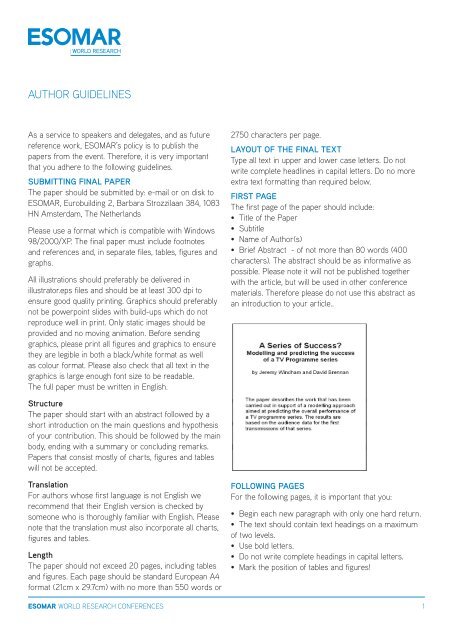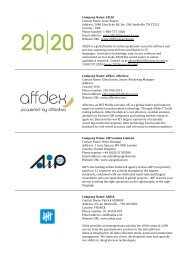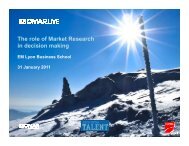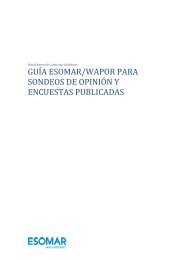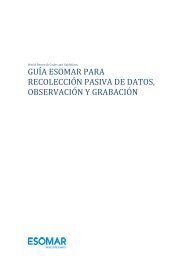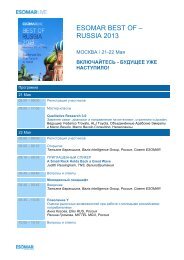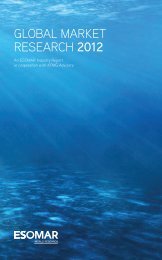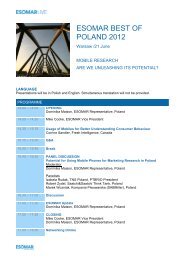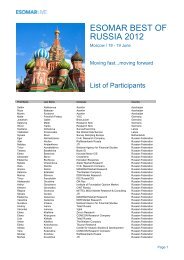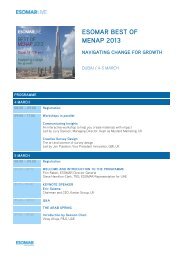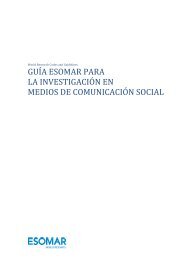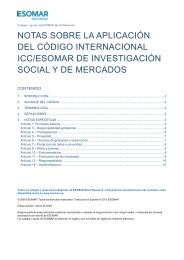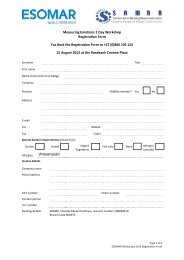download the PDF author guidelines - ESOMAR
download the PDF author guidelines - ESOMAR
download the PDF author guidelines - ESOMAR
Create successful ePaper yourself
Turn your PDF publications into a flip-book with our unique Google optimized e-Paper software.
AUTHOR GUIDELINES<br />
As a service to speakers and delegates, and as future<br />
reference work, <strong>ESOMAR</strong>’s policy is to publish <strong>the</strong><br />
papers from <strong>the</strong> event. Therefore, it is very important<br />
that you adhere to <strong>the</strong> following <strong>guidelines</strong>.<br />
Submitting Final PaPer<br />
The paper should be submitted by: e-mail or on disk to<br />
<strong>ESOMAR</strong>, Eurobuilding 2, Barbara Strozzilaan 384, 083<br />
HN Amsterdam, The Ne<strong>the</strong>rlands<br />
Please use a format which is compatible with Windows<br />
98/2000/XP. The final paper must include footnotes<br />
and references and, in separate files, tables, figures and<br />
graphs.<br />
All illustrations should preferably be delivered in<br />
illustrator.eps files and should be at least 300 dpi to<br />
ensure good quality printing. Graphics should preferably<br />
not be powerpoint slides with build-ups which do not<br />
reproduce well in print. Only static images should be<br />
provided and no moving animation. Before sending<br />
graphics, please print all figures and graphics to ensure<br />
<strong>the</strong>y are legible in both a black/white format as well<br />
as colour format. Please also check that all text in <strong>the</strong><br />
graphics is large enough font size to be readable.<br />
The full paper must be written in English.<br />
Structure<br />
The paper should start with an abstract followed by a<br />
short introduction on <strong>the</strong> main questions and hypo<strong>the</strong>sis<br />
of your contribution. This should be followed by <strong>the</strong> main<br />
body, ending with a summary or concluding remarks.<br />
Papers that consist mostly of charts, figures and tables<br />
will not be accepted.<br />
translation<br />
For <strong>author</strong>s whose first language is not English we<br />
recommend that <strong>the</strong>ir English version is checked by<br />
someone who is thoroughly familiar with English. Please<br />
note that <strong>the</strong> translation must also incorporate all charts,<br />
figures and tables.<br />
length<br />
The paper should not exceed 20 pages, including tables<br />
and figures. Each page should be standard European A4<br />
format (2 cm x 29.7cm) with no more than 550 words or<br />
<strong>ESOMAR</strong> WORLD RESEARCH CONFERENCES<br />
2750 characters per page.<br />
layout oF <strong>the</strong> Final text<br />
Type all text in upper and lower case letters. Do not<br />
write complete headlines in capital letters. Do no more<br />
extra text formatting than required below.<br />
FirSt Page<br />
The first page of <strong>the</strong> paper should include:<br />
• Title of <strong>the</strong> Paper<br />
• Subtitle<br />
• Name of Author(s)<br />
• Brief Abstract - of not more than 80 words (400<br />
characters). The abstract should be as informative as<br />
possible. Please note it will not be published toge<strong>the</strong>r<br />
with <strong>the</strong> article, but will be used in o<strong>the</strong>r conference<br />
materials. Therefore please do not use this abstract as<br />
an introduction to your article..<br />
Following PageS<br />
For <strong>the</strong> following pages, it is important that you:<br />
• Begin each new paragraph with only one hard return.<br />
• The text should contain text headings on a maximum<br />
of two levels.<br />
• Use bold letters.<br />
• Do not write complete headings in capital letters.<br />
• Mark <strong>the</strong> position of tables and figures!
AUTHOR GUIDELINES<br />
Followed by<br />
• Technical Appendices (optional)<br />
• Footnotes - Footnotes should not be used for<br />
reference purposes and should be avoided if possible.<br />
If necessary to improve <strong>the</strong> readability of <strong>the</strong> text, a few<br />
footnotes may be included at <strong>the</strong> end of <strong>the</strong> text. They<br />
should be numbered consecutively throughout <strong>the</strong> text.<br />
• References - References are very important for those<br />
who are interested in a special <strong>the</strong>me. References should<br />
be cited or referred to in <strong>the</strong> text as follows: (Brown and<br />
Peters, 993). They should be listed in alphabetical order<br />
and follow <strong>the</strong> text or - if included - <strong>the</strong> footnotes<br />
• The Author(s) - Name(s) of <strong>author</strong>(s) and present<br />
position or profession<br />
on SeParate PageS and in SeParate File<br />
Tables, numbered consecutively, each on a separate<br />
page. Please indicate <strong>the</strong> title of <strong>the</strong> table and <strong>the</strong> place in<br />
<strong>the</strong> text! Please avoid tabs and spaces when formatting<br />
tables.<br />
on SeParate PageS and in SeParate File<br />
Figures, numbered consecutively, each on a separate<br />
page. Please indicate <strong>the</strong> title of <strong>the</strong> figures and <strong>the</strong> place<br />
in <strong>the</strong> text!<br />
<strong>ESOMAR</strong> WORLD RESEARCH CONFERENCES<br />
accePtance oF Final PaPer<br />
<strong>ESOMAR</strong> and /or <strong>the</strong> Programme Committee, having<br />
accepted your outline, still reserve (s) <strong>the</strong> right to<br />
exclude <strong>the</strong> paper from <strong>the</strong> conference. Exclusions will<br />
be for <strong>the</strong> following reasons:<br />
a) <strong>ESOMAR</strong> reserves <strong>the</strong> right to refuse any contribution<br />
as it deems appropriate to avoid conflicts of interest The<br />
ICC/<strong>ESOMAR</strong> International Code of Marketing and Social<br />
Research Practice prohibits from combining marketing<br />
research and direct marketing activities in one project.<br />
(See ICC/<strong>ESOMAR</strong> International Code, <strong>the</strong> <strong>ESOMAR</strong><br />
Guideline on Maintaining <strong>the</strong> Distinction between<br />
Marketing Research and Direct Marketing, and o<strong>the</strong>r<br />
codes at www.esomar.org<br />
b) <strong>ESOMAR</strong> has been notified of <strong>the</strong> contribution<br />
infringing <strong>the</strong> copyright, right of use or any o<strong>the</strong>r right of<br />
intellectual property of (co-) <strong>author</strong> (s), client (s) and/or<br />
o<strong>the</strong>r third parties<br />
c) The paper has been presented or published<br />
elsewhere<br />
d) The paper has a commercial slant<br />
e) The paper is not a true reflection of <strong>the</strong> accepted<br />
outline<br />
f) The paper has not been received by <strong>the</strong> deadline<br />
2


